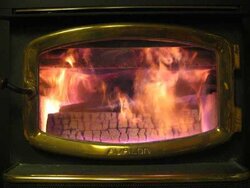- Jan 27, 2007
- 5
Folks,
I have a 12 year old Avalon 996 installed as a fireplace insert, and I've never been able to get more than a 3 hour burn time out of this puppy. It vents into the fireplace flue with a 6" liner that runs the full height - 24 feet. That's a tall stack, but that's the height of the chimney - no choice about that. 4 years ago I replaced the door gasket and installed the liner. (It used to just vent into the 12" flue.) That helped some, but lately it's more or less back to its old ways. My typical load is 3 pieces of 3-5" thick good dry ash or maple.
I went around the edges of the door with a smoky piece of kindling and didn't see any obvious air intake around the door. This unit has the old lever damper control at the bottom right, and I've always had the feeling that the damper doesn't close very well. The unit doesn't overheat, but burns brightly with a top temperature of 350-400 with the damper pushed shut. There were two 3/8" bypass holes on either side that I've already plugged. Unfortunately a flue damper isn't really an option because the entire flue is enclosed.
Any bright ideas on how I can slow this thing down a bit? The good news is it's nice and clean. (I clean the flue once a year and get out half a bucket of dry powder.)
Thanx much - Andy
I have a 12 year old Avalon 996 installed as a fireplace insert, and I've never been able to get more than a 3 hour burn time out of this puppy. It vents into the fireplace flue with a 6" liner that runs the full height - 24 feet. That's a tall stack, but that's the height of the chimney - no choice about that. 4 years ago I replaced the door gasket and installed the liner. (It used to just vent into the 12" flue.) That helped some, but lately it's more or less back to its old ways. My typical load is 3 pieces of 3-5" thick good dry ash or maple.
I went around the edges of the door with a smoky piece of kindling and didn't see any obvious air intake around the door. This unit has the old lever damper control at the bottom right, and I've always had the feeling that the damper doesn't close very well. The unit doesn't overheat, but burns brightly with a top temperature of 350-400 with the damper pushed shut. There were two 3/8" bypass holes on either side that I've already plugged. Unfortunately a flue damper isn't really an option because the entire flue is enclosed.
Any bright ideas on how I can slow this thing down a bit? The good news is it's nice and clean. (I clean the flue once a year and get out half a bucket of dry powder.)
Thanx much - Andy


